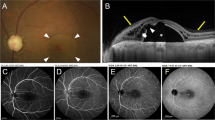Abstract
Background
To report on the spontaneous closure of a full thickness juxtafoveolar idiopathic macular hole (IMH) monitored with fundus autofluorescence (AF) as well as optical coherence tomography (OCT) imaging.
Methods
Observational case report. Fundus Autofluorescence with a confocal SLO (HRA, Heidelberg Engineering,Germany) and OCT imaging were used to monitor the spontaneous evolution of a stage II IMH.
Results
A 70 year-old woman with unremarkable ocular history received a diagnosis of idiopathic macular hole in the left eye. Bright autofluorescence corresponding to the IMH was documented with the confocal SLO and OCT imaging could confirm the presence of an hour glass shaped full thickness juxtafoveolar IMH. Biomicroscopy revealed no posterior vitreous detachment (PVD). Few months later clinical examination demonstrated the presence of typical symptoms and signs of PVD (miodesopsias and Weiss ring). The bright autofluorescence corresponding to the IMH disappeared and OCT imaging documented a normal fovea in morphology and thickness.
Conclusions
Spontaneous closure of full thickness juxtafoveolar IMH can occur and may be properly monitored with fundus AF as well as OCT imaging.




Similar content being viewed by others
References
Gass JDM (1995) Reappraisal of biomicroscopic classification of stages of development of a macular hole. Am J Ophthalmol 119:752–759
Azzolini C, Patelli F, Brancato R (2001) Correlation between optical coherence tomography data and biomicroscopic interpretation of idiopathic macular hole. Am J Ophthalmol 132:348–355
Von Ruckmann A, Fitzke FW, Bird AC (1995) Distribution of fundus autofluorescence with a scanning laser ophthalmoscope. Brit J Ophthalmol 79:407–412
Von Ruckmann A, Fitzke FW, Gregor ZJ (1998) Fundus autofluorescence in patients with macular holes imaged with a laser scanning ophthalmoscope. Brit J Ophthalmol 82:346–351
Ciardella AP, Lee GC, Langton K, Sparrow J, Chang S (2004) Autofluorescence as a novel approach to diagnosing macular holes. Am J Ophthalmol 137:956–959
Author information
Authors and Affiliations
Corresponding author
Rights and permissions
About this article
Cite this article
Milani, P., Seidenari, P., Carmassi, L. et al. Spontaneous resolution of a full thickness idiopathic macular hole: fundus autofluorescence and OCT imaging. Graefes Arch Clin Exp Ophthalmol 245, 1229–1231 (2007). https://doi.org/10.1007/s00417-006-0530-0
Received:
Revised:
Accepted:
Published:
Issue Date:
DOI: https://doi.org/10.1007/s00417-006-0530-0




